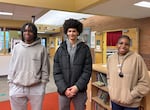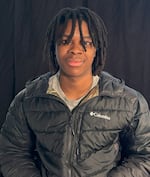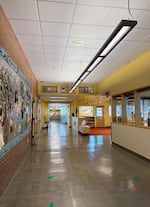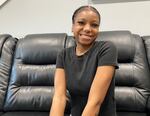OPB has been following 27 students since they were in first grade as part of the Class of 2025 project to track the state's progress toward 100% high school graduation starting in 2025.
It’s late afternoon at Earl Boyles Elementary School in Southeast Portland. The school is mostly empty, except for afterschool programs in a few classrooms, and three former students who are now teenagers.
Josh arrives first with his mom, Sharnissa Secrett. They take off on a short tour of Josh’s old elementary school — the spot where his educational career and OPB’s Class of 2025 project — started.
Later, Josh, 17, talks about spotting his first-grade teacher.
“It was good to talk to her,” he said. “It’s been a long time since I’ve seen her, a long time.”
Azaysha and her mom, Shontia Foster, arrive next. Sixteen-year-old Azaysha is hit with nostalgia immediately.
“As soon as I walked in, the memories hit,” she said. “It felt just like my childhood.”
But she’s also hit with something else.
“I feel old — definitely too big to be in here, like it doesn’t feel right.”
As soon as Rayshawn, 16, walks in, he turns left towards the cafeteria, almost like it’s second nature.
“I miss it,” Rayshawn said of his elementary school years. “I want to go run and play and have all the old energy that I did.”
These three students are part of the Class of 2025, a group of 27 students OPB has been following since their families were invited to participate in this yearslong reporting project and help track the state’s progress toward its 100% graduation goal by 2025.

(Left to right) Josh, Rayshawn, and Azaysha at Earl Boyles Elementary School on May 2, 2024. The students all started school together at Earl Boyles but now attend three different high schools across Portland. They're all on track to graduate.
Elizabeth Miller / OPB
The 27 students come from different racial, cultural and family backgrounds. Josh, Azaysha and Rayshawn are all Black students in the Class of 2025.
Black students make up just 2.4% of Oregon’s 547,000 students according to the state’s October 2023 student count. Efforts like the state’s Black/African American Student Success Plan include goals to increase attendance and graduation rates. But the state has failed to meet the goals, just as it remains well short of the 100% graduation goal schools are supposed to reach by next year.
At the same time, many Black students are successful in Oregon schools. Take Azaysha, Josh, and Rayshawn, three students wrapping up their junior year in three different high schools across the city.
Azaysha is at Portland Public Schools’ historically Black high school, Jefferson, a small school where she is surrounded by other Black students and Black support staff.
“I just immediately fell in love with the whole school, the whole atmosphere,” Azaysha said. “It’s just really a place I felt like I’m at home … I feel like I can be myself at Jeff.”
Josh has stayed in the same school district his whole educational career. He’s now a year away from graduating from David Douglas High School — one of the largest and most diverse public high schools in the state, where students speak 46 different languages.

Josh, a student in OPB’s Class of 2025 project, is wrapping up junior year at David Douglas High School. He’s been in the same school district for his educational career – starting at Earl Boyles Elementary in Southeast Portland.
Elizabeth Miller / OPB
“It’s a lot of people I wouldn’t have expected to meet or see,” Josh says. “A whole bunch of different backgrounds and that’s pretty cool to me, how much I can learn from those people.”
After moving schools freshman year, Rayshawn has been at Rosemary Anderson, an alternative high school in Portland with about 100 students and a small staff that gets to know students personally.
“It’s like relationship before education, but education is still up there,” Rayshawn said. “But they try to connect with you instead of just ‘do this, do this’. They actually understand what you’re going through and then find a way to teach you with your struggles.”
Black students tend to get mentioned in stories about Oregon’s test score “achievement gap,” or in coverage of disproportionate discipline rates among student groups.
Those stories don’t often include the voices of students themselves, and it’s worth hearing from them.
Azaysha, Josh, and Rayshawn have had different experiences in Oregon’s public schools, but they are all on track to graduate next year.
Growing up, fitting in, and figuring out who you are
Azaysha was the first of these three students to leave the David Douglas School District partway through elementary school, when her family moved closer to the center of Portland. Only about half of the 27 students in OPB’s Class of 2025 remain in the David Douglas district, mostly a result of families moving.

The hallway at Earl Boyles Elementary School in southeast Portland, where the Class of 2025 students started kindergarten in 2013. Most of the Class of 2025 students are wrapping up their junior year.
Elizabeth Miller / OPB
Azaysha went to several different schools throughout elementary and middle school. She’s a bubbly teen who loves TikTok and playing softball.
Despite her love for school, she didn’t always have good experiences. She said was bullied, and it felt like her classmates didn’t accept her.
“I’m thinking, ‘Oh no, we’re just friends, they’re just joking.’ But no, it was actually a lot of bullying that I went through,” Azaysha recalled.
Josh says he remembers working to “fit in” in middle and high school, finding himself in big, popular groups that were involved in a lot of “conflict” as he put it.
“I got lucky to actually not be getting in trouble during that time, even though I was hanging around with people who were getting in trouble.”
He said during his sophomore year of high school, he realized he didn’t want to be a part of those groups. As a junior, he feels more open to associating with different people, including some of his old friends.
“It’s kind of weird, because this year, I’m going back to those groups … I feel like I’m still quiet, like being able to be myself and be able to talk to more people.”
“Am I this person or am I not that person?”
Azaysha says she’s still figuring out what kind of person she is too. In high school, she changed schools one last time when she transferred to Jefferson during her sophomore year.
“Jeff really just brought out the real me, let me be myself rather than how I was after being bullied.”
“I feel like now I really realized I can be who I want to be, and if people don’t accept it, why would I care? Who really cares?” she said. “So, I started being myself and people just loved it, so it’s like, what was I scared about this whole time?”
What keeps students on track to graduate?
When Rayshawn first transferred to Rosemary Anderson his freshman year, he struggled academically. He missed assignments and fell behind.
But by spring of freshman year, things had turned around.
Two years later, Rayshawn is on track to graduate from Rosemary Anderson. He said small classes and individual attention at school have helped.
“The teachers and the staff members and the principals, they’re on you to do better,” he said.
Rayshawn has always been a bit of a class clown, making jokes and talking in class. His freshman year, he was suspended from David Douglas, caught with his friends in possession of an airsoft gun.
He hasn’t lost his sense of humor at Rosemary Anderson; he still cracks jokes, laughing with his classmates or with Roy “Yab” Rhone, the school’s Dean of Students. But he says staff hold students accountable, and he feels he’s grown into a role model for the younger students.

Class of 2025 student Rayshawn is wrapping up his junior year at Rosemary Anderson High School, an alternative school with campuses all over Portland. Rayshawn says one on one attention and staff support have helped him stay on track to graduate.
Kate McMahon / OPB
“There’s a lot of kids right now at my school that came from like, family stuff, and then they dropped out of high school sophomore, junior year with like 12 credits left, and then they come in and they graduate on time,” he said.
“You just have to put in the work and show that you want to accomplish that goal.”
At their respective schools, both Azaysha and Josh are varsity athletes. Josh plays basketball. He says being a student-athlete keeps him engaged in school.
“I definitely have to live to a higher standard and do more because of the sport … I have to be kind of like a role model basically,” he said.
Azaysha, a cheerleader and softball player, feels similarly about her role at Jefferson.
Statewide, graduation rates for Black students have improved over the years, reaching 73% for the Class of 2023, up from 60% for Black students in 2014. But that improved rate is still below the state average for all students.
The situation is different at Jefferson, where more than 95% of the school’s Black students graduated on time last year — a few points higher than the school’s overall graduation rate. At David Douglas, the graduation rate for the Class of 2023 was 74%, with Black students slightly lower, at 70%.
As an alternative school, Rosemary Anderson is not required to share graduation rate data with the Oregon Department of Education.
Support at school and at home
Every morning, Azaysha drives across town from her house in Southeast to Jefferson in North Portland.
To hear Azaysha talk about Jefferson is to hear a student who feels supported. At lunchtime, she says sometimes staff will play music — music students actually want to listen to.
“It’ll be like old-school music,” Azaysha said. “To hear everybody sing the same song — like, oh my gosh, “Love” by Keyshia Cole is going to get them every time.”

Azaysha is a junior at Jefferson High School in Portland. She started elementary school with the rest of the Class of 2025 at Earl Boyles, but changed schools throughout elementary, middle, and high school. She moved schools for the last time sophomore year, and says she feels “at home” at Jefferson.
Elizabeth Miller / OPB
She says the occasional lunchtime soundtrack is an example of the school’s connection to culture and its community.
She participates in activities with Self Enhancement Inc., a nonprofit that supports Black students and has several staff members based at Jefferson.
Through SEI, Azaysha had the chance to go on a tour of historically Black colleges and universities. Now she wants to enroll at one of those colleges to become a nurse.
While SEI and other staff at Jeff are often Black, teachers are predominantly white. That’s the case with David Douglas and Rosemary Anderson too. But the students say staff acknowledge race and show support for students of color.
Azaysha said that wasn’t the case at her old high school.
“I was always the bad guy, I was always aggressive, and I was always doing too much, but I feel like at Jeff, the teachers are a lot more understanding because they deal with so many of the same kids that they understand and they try to connect more,” she said.
In addition to staff at school, the three students all have strong families supporting them at home. Josh and Azaysha’s mothers sat together listening as the three former classmates talked about their lives at school. Secrett, Josh’s mom, said having support at home allows the students to focus on themselves and not worry about the broader world around them.
“I love to hear that they are thriving in this environment — with everything,” Secrett said. “The parents know, we see what we see and we know what we are up against systematically with racism and everything.”
Perception, opportunities, and the future
But there is a broader world. Portland is a majority-white city in a majority-white state with a racist history.
Azaysha said there’s so much good happening at her school, but sometimes the bad seems to overshadow that.
“People think it’s, oh so dangerous, when really it’s just another dangerous high school in Portland. It’s not just because it’s predominantly Black, it’s because it’s a high school in Portland,” she said.
“There’s so many students at Jefferson that apply themselves, so many students who have very large scholarships to all these colleges, and no one knows about that — everyone just knows about the bad test scores, things like that.”
Alternative schools can also get a bad rap. State leaders have raised concerns about a lack of accountability for alternative schools, yet they serve students at the greatest risk of not graduating.
If Rayshawn went back to David Douglas, he said he’s not sure he’d be doing as well as he is now.
“I think I’d get way more distracted, get in a little bit more trouble,” he said.
“In my personal opinion, I think it’s better than a regular high school,” he said of his school. He said it’s easier to focus at Rosemary Anderson, and other opportunities like internships and connections to trade schools.
“You’re there to do your work,” he said.
What these three students articulate in their statements and demonstrate in their school careers is that there’s not just one type of Black student in Portland, or in Oregon. Like any student, every student’s experience is different, from the school they go to, to their plans for the future.

A mural at Earl Boyles Elementary in southeast Portland in the main entrance of the school. OPB’s Class of 2025 project started at Earl Boyles more than 10 years ago. Today, the students in the Class of 2025 are wrapping up their junior year of high school.
Elizabeth Miller / OPB
“Honestly, growing up Black in Portland is different for everyone,” Azaysha said.
“I have friends from so many different backgrounds that live so many different lifestyles.”
Josh is happy with how he’s doing. Playing basketball has been influential for him. “I’m glad I led myself in this direction,” Josh said.
“I feel like sports kept me into school, kept me wanting to go to school basically. And now I’ve gotten where I want to be and we keep going to see where I end up at.”
“Growing up in Portland was interesting, it’s definitely Portland — definitely keeping it weird here,” Azaysha says with a laugh.
But growing up here doesn’t mean these students want to stay here. After spending his entire school career in Southeast Portland, Josh isn’t sure where he wants to go in the future. Azaysha and Rayshawn, both of whom have been through big school changes, are ready to leave Portland.
Correction: An earlier version of this story incorrectly identified Shontia Foster. OPB regrets the error.
